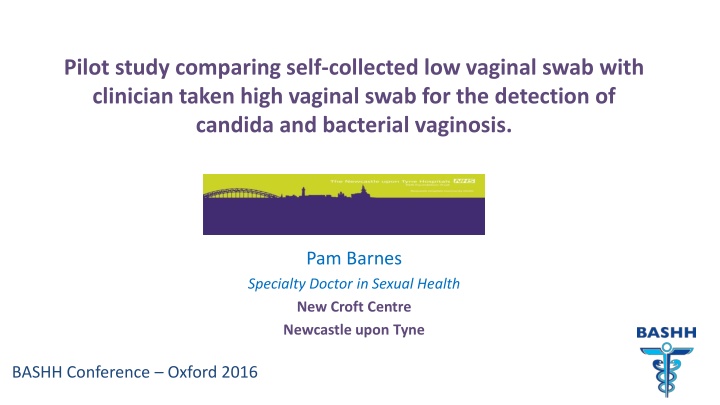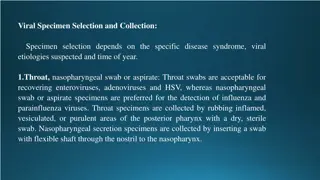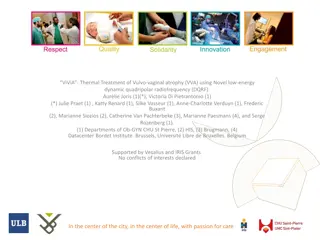Comparative Study on Self-Collected vs. Clinician-Taken Vaginal Swabs for Candida and BV Detection
This pilot study conducted by Dr. Pam Barnes at the BASHH Conference in 2016 compares the effectiveness of self-collected low vaginal swabs with clinician-taken high vaginal swabs for detecting candida and bacterial vaginosis. The study design, results, correlation of symptoms with diagnoses, and statistical analysis using Cohen's Kappa coefficient are discussed in detail.
Download Presentation

Please find below an Image/Link to download the presentation.
The content on the website is provided AS IS for your information and personal use only. It may not be sold, licensed, or shared on other websites without obtaining consent from the author.If you encounter any issues during the download, it is possible that the publisher has removed the file from their server.
You are allowed to download the files provided on this website for personal or commercial use, subject to the condition that they are used lawfully. All files are the property of their respective owners.
The content on the website is provided AS IS for your information and personal use only. It may not be sold, licensed, or shared on other websites without obtaining consent from the author.
E N D
Presentation Transcript
Pilot study comparing self-collected low vaginal swab with clinician taken high vaginal swab for the detection of candida and bacterial vaginosis. Pam Barnes Specialty Doctor in Sexual Health New Croft Centre Newcastle upon Tyne BASHH Conference Oxford 2016
Back ground to the study Hypothesis that self taken swabs would be as good as clinician taken swabs for the diagnosis of BV and VVC. Particularly relevant to non-GU services Provide evidence that could change practice. BASHH Conference Oxford 2016
Study Design Case controlled study with the patient acting as her own control Symptom criteria: Change in normal vaginal discharge Vulval irritation Offensive genital smell. - Vulval pain Participants took a self-collected LVS prior to speculum insertion and vaginal examination, during which a clinician took a HVS. Main outcome measure: Diagnosis of BV or VVC infection with samples analysed in a microbiology department using both microscopy and culture. Image result for medical wire BASHH Conference Oxford 2016
Correlation of symptoms with diagnosis Of the 104 women enrolled 97 had complete data for both BV and VVC 40 30 Genital pain Change in discharge 20 Vulval irritation/itching 10 Offensive discharge 0 Bacterial Vaginosis Candida B Vag and Candida Neither BASHH Conference Oxford 2016
Results(using laboratory diagnosis from clinician taken HVS as the reference standard) Data from 99 women for VVC and 97 women for BV 45 women were diagnosed with VVC of which LVS detected 43. 26 women were diagnosed with BV of which LVS detected 23. 5 women had both VVC and BV - LVS detected both in 4 31 had neither BV nor Candida of which LVS was negative in 26. . 11 women had an STI (8-Chlamydia, 2-GC+Chlamydia, 2-HSV) BASHH Conference Oxford 2016
Statistical analysis- Cohen's Kappa Coefficient Value of Kappa Level of Agreement % of Data that are Reliable Kappa coefficient looks at the level of agreement between 2 different observers. . 0 0.20 None 0 4% 0.21 0.39 Minimal 4 15% Calculates the percentage probability that this is not due to chance. 0.40 0.59 Weak 15 35% 0.60 0.79 Moderate 35 63% 0.80 0.90 Strong 64 81% BASHH Conference Oxford 2016 Above 0.90 Almost Perfect 82 100%
Kappa Score for Bacterial Vaginosis Clinician taken HVS BV not diagnosed Clinician taken HVS BV diagnosed Self collected LVS Grand total LVS-BV not detected 68 3 71 LVS-BV detected Grand total 3 23 26 26 97 71 Number of observed agreements: 91 ( 93.81% of the observations) Number of agreements expected by chance: 58.9 ( 60.76% of the observations) Kappa= 0.842 SE of kappa = 0.062 BASHH Conference Oxford 2016
Kappa Score for Vulvo-vaginal Candidiasis Clinician taken HVS VVC not diagnosed Clinician taken HVS VVC diagnosed Self-collected LVS Grand total LVS- VVC not detected 50 2 52 LVS- VVC detected Grand total 4 43 45 47 99 54 Number of observed agreements: 93 ( 93.94% of the observations) Number of agreements expected by chance: 49.7 ( 50.23% of the observations) Kappa= 0.878 SE of kappa = 0.048 BASHH Conference Oxford 2016
Interpretation of results VVC Kappa coefficient 0.878 = Strong agreement! BV Kappa coefficient 0.842 = Strong agreement! Self collected Sensitivity 95% CI Specificity 95% CI PPV NPV LVS VVC detection 0.955 0.836-0.992 0.926 0.813-0.976 0.915 0.962 BV detection 0.885 0.687-0.970 0.958 0.873-0.990 0.885 0.957 BASHH Conference Oxford 2016
Conclusions This study shows a strong correlation between self-collected and physician collected vaginal swabs in the diagnosis of VVC and BV. Although originally designed as a pilot study our Kappa scores indicate that this study is sufficiently powered to be valid. Patient perception of their discharge is not a reliable indicator of likely pathology. Self-collected LVS are not a substitute for genital examination but in a time constrained service LVS appears to have equivalent detection rates to HVS. BASHH Conference Oxford 2016























